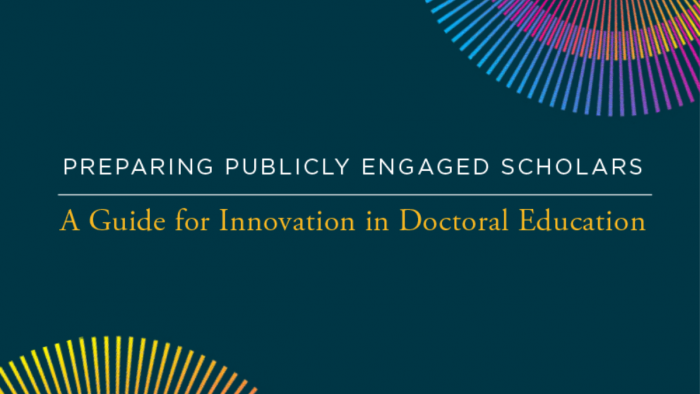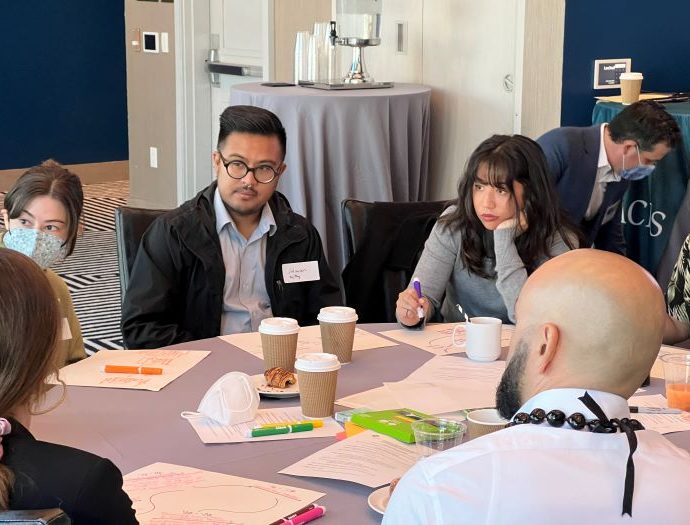


PhD curricula often assume students have similar backgrounds, motivations for doing research, and career goals. How can PhD programs account for and value the varied experiences people bring to PhD programs?
Preparing Publicly Engaged Scholars: A Guide to Innovation in Doctoral Education offers examples of approaches to doctoral education responsive to the diverse aspirations of current and future generations of PhD students. Graduate students are the future of publicly engaged humanistic scholarship—whether as faculty in universities and colleges or in workplaces and activist spaces across the country. Here are eight key recommendations made in the report for doctoral faculty, students, administrators, and research funders to support these scholars.
Value the experiences, skills, interests, and connections that graduate students bring to their studies, not just the ones they will develop along the way. The chapter “Build Bridges, Not Walls” (Boehm, Salas, Salas Crespo, and Walls) shows how previous student experiences are invaluable to community-engaged projects. In “Enabling Community-Engaged and Public-Facing PhDs,” Anjaria and King remind us that these experiences and interests are what bring students to the program. Don’t require them to leave those behind.
Make space for collaborative pedagogy, as seen in “Combahee Taught Us” (Radford Shorts, Johnson, and Lindsey). Consider letting go of top-down control, in order to learn together and build shared goals.
Build cohorts, especially when participants are doing something out of the ordinary. Cohort admits (described in “Weaving a Web Together” by Tosaya, Irwin, and Joseph) are one way to do this.
Students should connect with multiple mentors and sources of support. Connection with community knowledge can be particularly sustaining for Indigenous students (see “A Canoe Concept Toward Sustained Indigenous Connections” by Baricuatro, Camacho, Colello, Guerrero, Pico, and Na’puti).
Consider how connections across your campus can support students, provide a multiplied voice, and share resources. In addition, building connections with community partners is how the work gets done. Prioritize reciprocal relationships and ethics of care. “Caring for Stories in Community-Engaged Research and Coalitional Work for Justice” by Bloom-Pojar and Koepke reminds us to build connections without requiring immediate results.
The path of community-engaged work can be unexpected. Students and faculty need flexibility (of time and project planning) to follow promising directions. But they may also need to be flexible in their hopes for any community-engaged project. Both stepping into a project to pursue a promising direction and stepping back to prioritize other goals may be necessary.
Consider flexibility in what “counts” as a dissertation and for tenure and promotion. As Gudis and Romano discuss in “Putting a Human Face to Public Humanities,” publicly engaged scholarship often involves outcomes other than academic articles and monographs.
Give faculty the time and resources to conduct publicly engaged work so they can bring graduate students into the work, teach courses that allow students to develop ideas and projects, mentor students, and serve as a model for one kind of future employment.
Faculty also need support to implement good reporting and relationship-building practices with department alumni, which is essential for connecting current students to PhDs pursuing non-faculty careers.


PhD curricula often assume students have similar backgrounds, motivations for doing research, and career goals. How can PhD programs account for and value the varied experiences people bring to PhD programs?
Funding graduate work on engaged projects (whether through research assistantships or internships) enables them to do that work and develop those skills. Often students can’t do this work if they’re only able to rely on teaching assistantships for their funding.
Community-engaged work also requires time from partner organizations and community members. Compensating participants and partners is a key feature of reciprocal and equitable research relationships.
Requiring training in publicly engaged methods of research, writing, and teaching, or incorporating it as core curriculum, demonstrates that these skills and projects are valued and helps graduate students participate.
This training can be incorporated through a specialization, an internship or practicum, a course, or in a talk series. “Teaching Public Humanities in Practice” (Friedman and Son) and “Public Humanities Pedagogy, Justice-Centered Methodologies, and Community Empowerment” (McCormick, Casanova, Smith, Franklin, and Brister) explore the value of public humanities courses. As Ristovska and Pointer (“Exploring Diverse Justice-Driven Careers for Publicly Engaged Doctoral Students”) argue, incorporating speakers employed outside the academy into regular departmental talk series demonstrates the range of career directions.
Graduate students should be explicitly engaged by faculty and community partners in naming the skills and expertise they are developing through their coursework and their involvement in projects, as both Bloom-Pojar and Koepke and Friedman and Son argue. Both Anjaria and King and Ristovska and Pointer also argue that this skill building may need to be an explicit part of the curriculum. These skills can range from those traditionally considered humanities skills, such as close reading, to those that may be essential for the implementation of publicly engaged projects, such as audio editing.
Publicly engaged work must consider how to collaborate ethically in the context of ongoing societal inequities. Both “Combahee Taught Us” (Radford Shorts, Johnson, and Lindsey) and “A Canoe Concept” (Baricuatro, Camacho, Colello, Guerrero, Pico, and Na’puti) demonstrate how some community-engaged education has been formulated in response to racism and colonialism, both inside and outside the university, and as part of an effort to build communities working against it. “Weaving a Web Together” (Tosaya, Irwin, and Joseph) shows how connections between students can help mitigate the impacts of racism and sexism.


We are working toward what we call a “new academy” that is just and equitable, providing supportive and smooth paths for all, including first-generation scholars, women, scholars of color, and scholars pursuing innovative approaches to scholarship that may encounter resistance. Opening up pathways in doctoral education that will embrace and foster publicly engaged scholarship is part of that work.